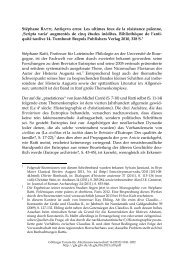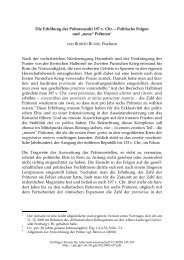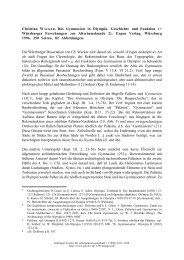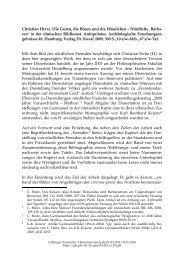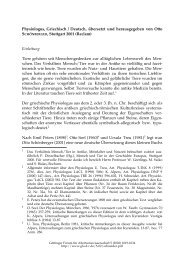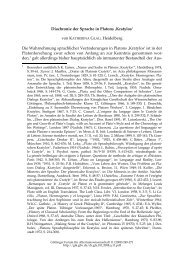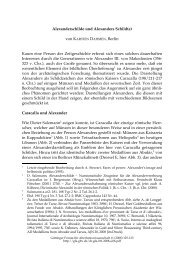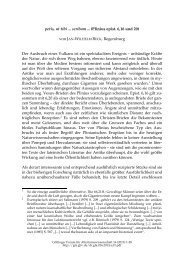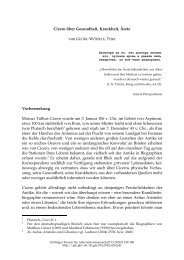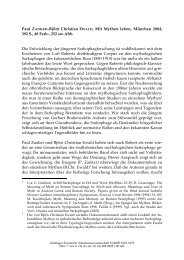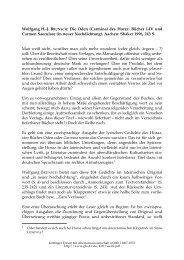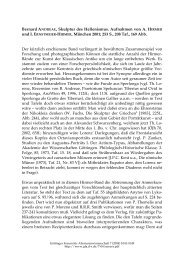The Bee Simile - Göttinger Forum für Altertumswissenschaft
The Bee Simile - Göttinger Forum für Altertumswissenschaft
The Bee Simile - Göttinger Forum für Altertumswissenschaft
You also want an ePaper? Increase the reach of your titles
YUMPU automatically turns print PDFs into web optimized ePapers that Google loves.
150 Wolfgang Polleichtner<br />
IV Vergil, the <strong>Bee</strong>, and Contemporary Interests<br />
Besides these obvious allusions to the epic poems of Homer and Apollonius<br />
there are various reasons why the bee was indeed a very useful subject for the<br />
kind of similes Vergil used it for. <strong>The</strong> Aristaeus episode in the fourth book of<br />
the Georgics that is about the loss and the regaining of beehives has been seen<br />
as an attempt to parallel the Augustan renewal of the Roman people after the<br />
long period of civil wars. This passage which, as I have said, underlies the first<br />
book of the Aeneid has also been seen as a direct allegory of Cleopatra, Marc<br />
Antony, Octavian, and Actium. 228 <strong>The</strong>re are two observations which can make<br />
this view even a little bit more probable.<br />
<strong>The</strong> bee is the hieroglyph for “King” or “Queen of lower Egypt”. 229 Even if<br />
there seems to be no known inscription connecting Cleopatra VII directly with<br />
that title, it is tempting to think that Vergil knew about it.<br />
In addition, the noise of the souls in the underworld that is compared to the<br />
sound bees make in Aeneid 6.707-712 recalls a passage from Egyptian literature.<br />
When the sun god goes through the underworld at night, the talking and<br />
movement of the people down there is also likened to the noise of bees. 230<br />
Since we saw that this second bee simile has no immediate Homeric or Apollonian<br />
predecessor, maybe Vergil got the idea for this simile from Egypt. <strong>The</strong><br />
connection of the bee with Egypt would be an additional way to explain why<br />
Vergil gave much more prominence to the bees in his work than other epic<br />
poets did. Of course we have also to note Sophocles fr. 794 N and 69 N. Fr. 69<br />
N, in which we are informed that in earlier times souls about to be born again<br />
were called bees. Souls in the underworld are compared with bees in these<br />
fragments. Norden has suggested that Sophocles’ source was Vergil’s source<br />
as well and came from Orphic or Pythagorean contexts. 231 Furthermore, the<br />
bee and honey have a prominent place in the realm of burial in antiquity. 232<br />
<strong>The</strong>re seems to be even more to this Vergilian simile than we can see from our<br />
limited knowledge of ancient literature today.<br />
228 Cf. D. Nelis (1992) 3f. and 15-18. According to this view, Aeneas is modeled on Aristaeus.<br />
229 Cf. A. Gardiner (1988) 477: L2. For beekeeping in ancient Egypt in general also see E.<br />
Crane (1999) 161-171.<br />
230 Amduat, 8 th hour, upper register, first cave: see E. Hornung (1984) 141; cf. F. Hoffmann<br />
(1994) 9.<br />
231 Cf. E. Norden (1927) 306.<br />
232 Cf. E. Norden (1927) 306f.





